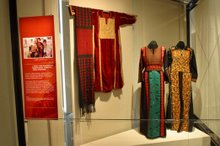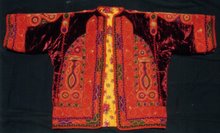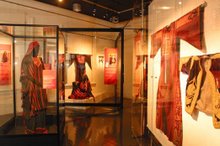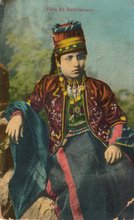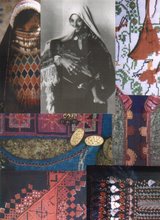 |
| LAP - "One book" campaign source |
Most Archive Education Officers and volunteers are familiar with Librarians and Archivists with Palestine ("a network of self-defined librarians, archivists, and information workers in solidarity with the Palestinian struggle for self-determination") because we've sung their praises quite a lot.
We rather like their latest project - a new reading campaign called “One Book, Many Communities" which is similar in concept to our own real time (wherever Archive staff are based) and cyber (when we meet online as a group) book club meetings and morning teas. So we thought we might take part :)
 |
| source |
"draws inspiration from the “one book, one town” idea—wherein people in local communities come together to read and discuss a common book. Librarians and Archivists with Palestine invites readers, librarians, and others to organize gatherings in January 2015 to discuss Mornings in Jenin, the acclaimed novel by Palestinian-American author and activist Susan Abulhawa.
"Mornings in Jenin is a sweeping, heart-wrenching historical saga about four generations of the Abulheja family. From Jenin to Jerusalem to Beirut to Philadelphia, the novel follows the family from its displacement from Ein Hod village in 1948 through love and loss over decades of life in Palestine and the diaspora.
“Every now and again a literary work changes the way people think. Abulhawa…has crafted a brilliant first novel about Palestine… [This] intensely beautiful fictionalized history… should be read by both politicians and those interested in contemporary politics.” – Library Journal
"LAP’s “One Book, Many Communities” campaign will introduce readers to the richness of Palestinian literature, and create a broader awareness and understanding of Palestinian history and the struggle for self-determination.
"Please join us! If you’re interested in organizing a reading group in your community, let us know and check back here soon for more information and resources. Book groups can be held at a library, university or school, at a local non-profit organization or community center, in your living room, or at a bookstore. If you schedule your event for sometime during the month of January 2015, you’ll be connected to readers across the globe who will be reading and discussing the book at the same time. Use your imagination! And let us know what you’re planning! "We thought we'd hold one in Canberra, but also wanted to suggest some of you - scattered around the world as Archive Education Officers and volunteer staff are - might like to hold one in your own town / country / city. Check out LAP's very useful "One book "reading group toolkit page on their website for how to plan an event / what type of format / date / venue / reading resources etc and don't forget to tell LAP. And us as well - like LAP we'll list on this blog and link to it on our Facebook page.
You might prefer just to attend one of the events LAP are co-ordinating. Keep an eye on LAP's events page as they'll be listing new events all the time over the next few months.
 |
| source |
Those of you near New York might like to attend the official launch of LAP’s “One Book, Many Communities” campaign and meet Susan Abulhawa who wrote Mornings in Jenin, at the Bluestockings Bookstore, Café + Activist Center on Saturday, November 8 at 7:00pm.
We are sure most of you are familiar with Susan Abulhawa - we first became aware of her via her Playgrounds for Palestine project and more recently always look out for her Electronic Intifada articles and book reviews - but if not you might like to check out her Wiki page which says of Mornings in Jenin:
"Abulhawa, who at the time was working for a drug company, visited Jenin as an international observer in the aftermath of the 2002 Israeli attack on a refugee camp there.
"The visit “transformed” Abulhawa, she later said. “You grow up as a Palestinian knowing about these massacres and the wars and the injustice but it was completely different to be there." "What I saw in Jenin was shocking at so many levels,” she later said, “but it was also quite humbling to watch how the people came together and shared what little they had. So when I left there, I really wanted to tell their story because I knew nobody was going to talk about it.”
"Returning to the U.S., she had trouble reconciling the concerns of her coworkers at the drug company with the travails of the people of Jenin. “They were two parts of my life and it was suffocating. A few months later I was laid off and it was probably the best thing that happened to me.” The result was a novel, Mornings in Jenin, which was published in 2010.
"It has been described as “a poignant, lyrical tale tracing four generations of the Abulheja family as they suffer loss after loss - first, with the kidnapping of their son Ismael in the 1948 Naqba by an Israeli soldier and then through their violent expulsion from their village near Haifa.” The novel follows the family through “successive horrors inflicted during the 1967 war, the siege of Lebanon and slaughters in Jenin, Sabra and Shatila, the devastation and agonies wreaked on ordinary Palestinians are depicted through the struggles of the book's protagonist Amal, whose brother Ismael is raised as the Arab-hating David.”
"The novel, published by Bloomsbury, has been translated into Arabic by Bloomsbury Qatar Foundation Publishing. It has also been translated into at least two dozen other languages and has become an international bestseller.
“In the Palestinian narrative,” she has said apropos of the book's story, “there are no two sides. There are no two sides to this conflict in the same way that there were no two sides to the Holocaust. There were no two sides to apartheid. There are no two sides to slavery. You have a nuclear power that is pitted against principally an unarmed civilian population. This is not a matter of sides.”
 |
| source |
We've got two copies of Mornings in Jenin in the Archive's Research Library, one in English and one in Arabic, which we can lend to anyone who wants to read it, but let us know quickly as there will probably be a bit of queue of people wanting it. Also you could buy a copy yourself - links below.
We thought we might hold our Canberra book reading at Zar Bakery and Cafe (Canberra's only Palestinian food outlet) as that way no one has to worry about catering and exact numbers re attendees. If you've not tried Zar's yet have a read of our earlier post.
For those interested in attending a Canberra event, get in touch via our Facebook page. We'll also be discussing the Canberra event idea further when we meet up for our next cyber morning tea and also when we meet up for the Sydney and Canberra parts of the Palestinian Film Festival which is in the first half on November.
More Info:
- Librarians and Archivists with Palestine
- Librarians and Archivists with Palestine on Facebook
- Librarians and Archivists with Palestine - “One Book, Many Communities: Mornings in Jenin”
- Official launch of "Librarians and Archivists with Palestine's “One Book, Many Communities” Bluestockings Bookstore, Café + Activist Center New York on Saturday, November 8 at 7:00pm
- Susan Abulhawa
- Mornings in Jenin (you can purchase an autographed copy via links on this website as well as the author's wonderful My Voice Sought The Wind)
- Mornings in Jenin on Facebook
- Playgrounds for Palestine
- Bluestockings Bookstore, Café + Activist Center
- LAP - list of "One book" events
- LAP - "One book" tool kit










